| |
| |

RED PINE
MANAGEMENT WORKSHOP
MANISTIQUE, MICHIGAN
10-11 SEPTEMBER 1997
 This workshop was primarily a field session with
visits to six sites in the Manistique area. About 240 people registered. A 3-ring
binder was provided containing 33 selected documents some about red pine. Additional
documents were distributed at some field sites. Three speakers delivered background
information before the tours during sessions at the Kewadin Inn. John Benzie
(retired USFS North Central Forest Experiment Station director) spoke about
the historical occurrence of red pine and silvicultural development. John wrote
the 1977 USFS manual on red pine management. Carl Ramm (MSU associate professor)
described the current resource (1993 FIA data) and discussed growth and yield
projections, including the RPAL growth and yield model. Mike Vasievich (USFS-NCFES,
Lansing) presented additional information about the current resource and economic
returns of red pine management. The entire workshop was preceded by a national
convention planning committee meeting (the 1998 convention
was in Traverse City), a Michigan SAF executive team
meeting, Chapter business meetings, and a State Society business meeting.
This workshop was primarily a field session with
visits to six sites in the Manistique area. About 240 people registered. A 3-ring
binder was provided containing 33 selected documents some about red pine. Additional
documents were distributed at some field sites. Three speakers delivered background
information before the tours during sessions at the Kewadin Inn. John Benzie
(retired USFS North Central Forest Experiment Station director) spoke about
the historical occurrence of red pine and silvicultural development. John wrote
the 1977 USFS manual on red pine management. Carl Ramm (MSU associate professor)
described the current resource (1993 FIA data) and discussed growth and yield
projections, including the RPAL growth and yield model. Mike Vasievich (USFS-NCFES,
Lansing) presented additional information about the current resource and economic
returns of red pine management. The entire workshop was preceded by a national
convention planning committee meeting (the 1998 convention
was in Traverse City), a Michigan SAF executive team
meeting, Chapter business meetings, and a State Society business meeting.
This web tour focuses on field visits to
give the viewer a rough idea of where the group went, a general idea of what
was discussed, and where additional information can be obtained. The following
bullets lead to bookmarks in the tour. At each tour stop you can press a "![]() [BEGIN TOUR]" button
that will bring you back here.
[BEGIN TOUR]" button
that will bring you back here.
![]() SITE A: MeadWestvaco plantation, site selection & herbicides,
chemical certification & licensing
SITE A: MeadWestvaco plantation, site selection & herbicides,
chemical certification & licensing
![]() SITE B: Old field conversion, forestry assistance programs, insects & diseases
SITE B: Old field conversion, forestry assistance programs, insects & diseases
![]() SITE
C: DNR plantation, jack pine vs. red pine, site prep with fire, chemical application
SITE
C: DNR plantation, jack pine vs. red pine, site prep with fire, chemical application
![]() SITE
D: USFS Ogontz seed orchard, natural regeneration & pest control through
prescribed fire, site index determination
SITE
D: USFS Ogontz seed orchard, natural regeneration & pest control through
prescribed fire, site index determination
![]() SITE
E: Thinning regimes, utility pole specifications, growth & yield
SITE
E: Thinning regimes, utility pole specifications, growth & yield
![]() SITE
F: Red pine old growth, wildlife considerations, visual character
SITE
F: Red pine old growth, wildlife considerations, visual character
![]() CITATIONS listed in the technical binder from the workshop
CITATIONS listed in the technical binder from the workshop
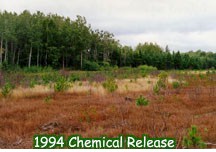

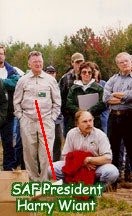
SITE A was a MeadWestvaco red pine plantation. It was planted in 1993 and
most recently released in the fall of 1994 using helicopter-applied Accord. The left photo
shows the effects on herbs, grasses, and shrubs. The site was cleared of snags for aerial
application. MeadWestvaco chemical treatment policy includes notification of adjacent landowners
and a posting with the name and number of a MeadWestvaco forester. In the middle photo, Bob Aschbacher (MeadWestvaco
regeneration operations forester), speaks about the plantation history,
site selection criteria, and recent treatment. To his right (our left) is Ernie Abel
(Michigan Department of Agriculture) who addressed pesticide application requirements and
procedures. Certification is regulated by the MDA and training provided by Michigan State
University Extension. For most forestry applications, a core class plus a forestry
applications class is needed. Kevin Furlong (Monsanto) discussed some of the research and
cooperative efforts that go into herbicide labeling. On the right, SAF President Harry
Wiant learns about red pine in Michigan. Harry was the keynote speaker at the banquet.
For more info you can contact Bob Aschbacher at 906-786-1660 x2157, Ernie Abel at 616-922-5210, and Kevin Furlong at 612-351-7775.
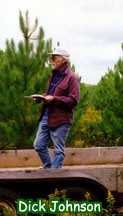
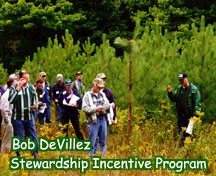
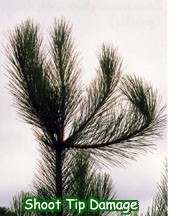
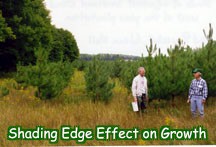
SITE B was a 10 acre red pine plantation owned by Dick Johnson. DNR
forester Bob DeVillez wrote the management plan under the State Stewardship Program and
assisted Dick with obtaining cost-share dollars. It was planted in 1990, at 900 trees per
acre on bare ground (trenary fine sandy loam) and sunflower stubble. A mechanical
transplanter was used with no herbicides the first year. Very little deer damage has been
noted. The seedlings were released from grass competition in May, 1991 using Velpar. The
day was sunny, temperatures to 80 degrees, with light winds. Buds had just started to
grow. No damage to seedlings was seen. Total establishment costs were reported at
$161/acre with Dick paying for about half.
At the Johnson tree farm, Bob Heyd (DNR) discussed damaging agents of young red pine plantations. Threats include various diseases of young seedlings including Scleroderris, Sirococcus shoot blight, and Armillaria root rot; and insect problems such as red-headed pine sawfly, Saratoga spittlebug, white grubs, bark beetles and shoot moths. Insufficient sunlight (photo shows the shading effect of the adjacent hardwood stand to the west) is also a potential problem for this shade intolerant tree. Once established on the proper site, red pine is a fairly disease and insect resistant tree species.
For more information you can contact Bob Heyd at 906-228-6561.
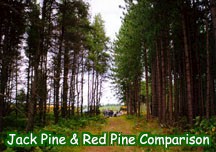
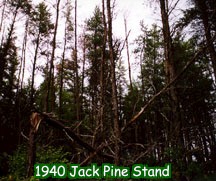
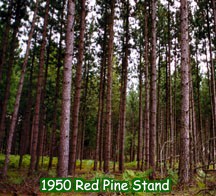
SITE C compared growth of adjacent red pine and jack pine plantations
on a DNR site. The red pine was planted in 1950, site index 65, contains 57 cords/acre,
was thinned in 1990 from 58 to 46 cords/acre, present growth at 1.2 cords/acre/year, and
has an average dbh around 9 inches. The jack pine was planted in 1940, site index 53,
contains 32 cords/acre, has not been thinned, present growth at 0.56 cords/acre/year, and
has an average dbh of around 6 inches. Clearly, the photo shows the jack pine stand in a
state of decline, while the red pine remains vigorous.
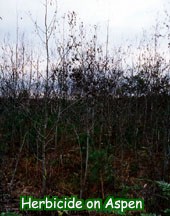
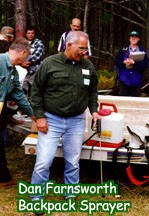
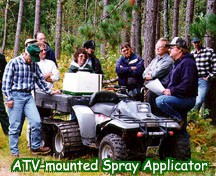
Also at this site, several modes of chemical application were displayed and discussed. Dan
Farnsworth demonstrated a backpack applicator and showed an ATV-mounted tank. Jeff
Stampfly, Don Kuhr, and Debra Huff spoke briefly about using prescribed fire for site
preparation, herbicide herbicide effects in an adjacent young plantation, and using
contracting to achieve desired results of forestry prescriptions. The effects of ground
application on aspen saplings were good.
For more information you can contact Dan Farnsworth at 906-293-5669, Jeff Stampfly at 906-452-6227 or Don Kuhr at 906-341-8463.
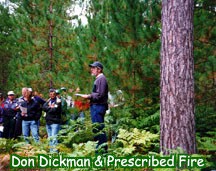
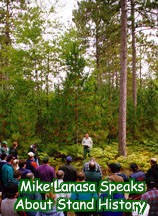
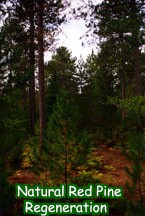
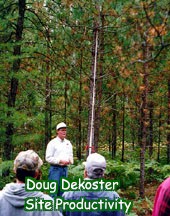
SITE D was the old Ogontz Seed Orchard, where Mike Lanasa (USFS)
described the history of the area, former seed collection methods, and spoke about the red
pine cone beetle (Conophthorus resinosae). The area is no longer used as a seed orchard.
Don Dickman (MSU) related the environmental conditions when prescribed fire can be
successfully used under mature red pine stands. Benefits include natural regeneration,
understory control, and suppression of certain insects and diseases. Prescribed fire can
also be used as a habitat management and ecosystem restoration technique. Doug Dekoster
(MeadWestvaco, now with Canal Forest Resources) reviewed various measures of site
productivity, including total height-total age, growth-intercept, soil-site analysis, and
habitat typing.
For more information you can contact Mike Lanasa at 906-786-4062 or mlanasa@fs.fed.us, Don Dickmann at 517-353-5199 or dickman1@msu.edu, or Doug Dekoster at 704-527-6780 x329 or Doug.DeKoster@Canal-Ind.com.
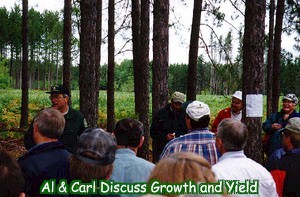
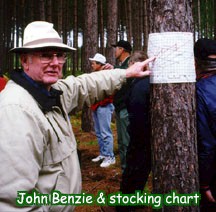
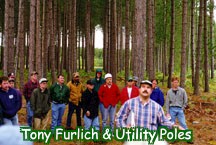
SITE E discussed growth and yield in a Hiawatha National Forest 1939
CCC red pine plantation. Al Saberniak (USFS) and John Benzie led the discussion. John
Benzie points out the path (in red) of this plantation on a red pine stocking chart. Tony
Furlich (Hydrolake) discussed utility pole production and specifications, and C.W. Ramm
added local color.
Al estimated site index at 65 feet (50 years). It was originally planted at approximately 1990 trees per acre. By age 40, there were about 915 TPA with an average dbh of 6.7 inches and a basal area was 240 square feet per acre. At that time, about 80 square feet were removed or about 275 TPA and 11 cords per acre. At age 51, a second thinning removed about 10 cords per acre or 250 TPA, and left a residual BA of around 130 square feet and 390 TPA, with a post-harvest dbh of 8.0 inches. In 1997 (age 58), a third thinning removed about 100 TPA and 7 cords per acre, bring the basal area down to about 125 square feet, with a post-harvest dbh of 9.0 inches.
For more information you can contact Al Saberniak at 906-387-2512 or Tony Furlich at 616-825-2233.
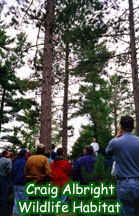
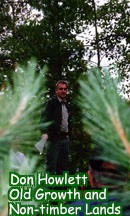
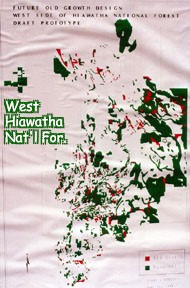
SITE F, on the Hiawatha National Forest offered examples of wildlife
considerations in red pine management in an area designated old growth in 1992 by the
Forest Service. This 50-acre stand has an origin of 1895, a basal area of 80 square feet,
an average dbh of 13 inches, and a site index of 51 feet. The site was underplanted with
200 oak seedlings in 1979, then thinned from below in 1981 (aspen removal). Craig Albright
(DNR) discusses factors affecting wildlife habitat quality such as stand age, stand size,
stocking density, adjacent forest types, within-stand vegetative diversity, and special
habitat structure. Red pine is not necessarily the "wildlife desert" described
by some biologists. Over 100 species of animals inhabit these kinds of red pine stands and
similar upland conifer types. Red pine stands should be part of landscape planning. Don
Howlett (USFS) discusses old growth and designation of non-timber production lands. 48
percent of the Hiawatha is designated either old growth (red on map) or as unsuited for
timber (green on map). Most of the unsuited lands are lowland conifer and other wetland
types. A portion of the "unsuited" category are upland sites with non-timber
objectives, including national recreation (Grand Island) and wilderness areas. The map,
difficult to read (sorry folks), includes Grand Island in the north, to Lake Michigan Big
Bay de Noc and the Stonington Peninsula in the south.
For more information you can contact Craig Albright at 906-786-2351 or Don Howlett at 906-786-4062.
The Red Pine Management Workshop happened because of the efforts by many people from the Upper Peninsula Chapter of the SAF. Program team members were Gary Carr, Doug Dekoster, Dan Farnsworth, Bill Hasse, Al Saberniak, and Ken Salo. Facilities, food, and transportation were arranged by Doug Dekoster, Richard Johnson, Carrie Sweeney, and Heidi Troyer. Dean Francis worked with the vendors and Forester's Fund raffle. Les Homan was the secretary/treasurer.
You've made it to the end of the field tour! Of course, nothing is better than being there and the workshop was a good one. If you have any questions about this on-line tour, you can e-mail Bill Cook, MSU Extension forester and Michigan SAF webmaster at cookwi@msu.edu This was Bill's first effort with this technology. Comments would be welcome!

This website is
maintained by Bill Cook, Michigan State University Extension
Forest in the Upper Peninsula. Comments, questions,
and suggestions are gratefully accepted.
Last update of this page was 21 September, 2005
This site is hosted by School of Forest Resources and Environmental Science at Michigan Technological University.